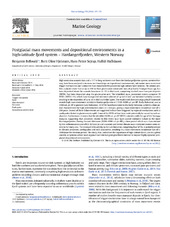| dc.description.abstract | High resolution acoustic data and a 15.7 m long sediment core from the Hardangerfjorden system, western Norway, have been analyzed to increase our knowledge on depositional environments, submarine mass movement trigger mechanisms and submarine mass movement frequencies in high latitude fjord systems. The seismic profiles analyzed show that an up to 160 m thick glacimarine-dominated unit, of probably Younger Dryas age, has been deposited above the acoustic basement. A < 55 m thick unit, comprising stacked mass transport deposits (MTDs) has been deposited atop the glacimarine unit. The identified mass movement events comprise 19 MTDs (MTD1–19), which have transported sediment volumes of up to 0.4 km3 and initiated turbidity currents resulting in the deposition of up to 13 m thick turbidite layers. The established chronostratigraphical framework reveals high mass movement activity in Hardangerfjorden at 11100–8200 cal. yrs BP (Early Holocene) and at 4100 cal. yrs BP to present (Late Holocene). 14 MTDs have been dated to the Early Holocene, which is a time period characterized by high sedimentation rates (1.1 mm/yr), giving a mass movement recurrence rate of 1/200 years. Several of these failure events are suggested to have been triggered by regional mechanisms such as earthquakes linked to glacioisostatic uplift. Some of the MTDs of that time could potentially be caused by rock avalanches. Furthermore, it seems that the identified 8200 cal. yrs BP MTD5 coincides with the age of the Storegga tsunami, suggesting that processes related to this event may have caused sediment failure in the inner Hardangerfjorden. During the mid-Holocene (8200–4100 cal. yrs BP), a time period which was characterized by low sedimentation rates of 0.1–0.2 mm/yr and a warmer and wetter climate, mass movement events were absent in the study area. The renewed slide activity in the Late Holocene, comprising four MTDs, is probably related to climatic processes, earthquakes and rock avalanches, resulting in a mass movement recurrence rate of 1/1000 years for this time period. This study, thus, underlines the importance of high-latitude fjords, also in a global context, as systems where local, regional and external geological forces interact to impose highly dynamic postglacial depositional environments. | en_US |

